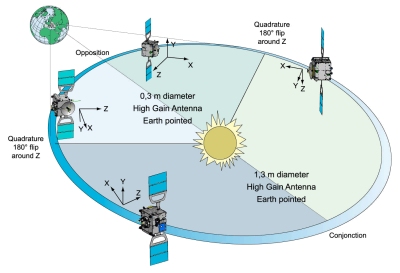Operational Orbit
The first Venusian day of the mission was devoted to global latitude, longitude, and local time coverage of the planet. The second day provides opportunities for filling observation gaps experienced during the first day, for studying in more detail objectives selected on the basis of the first day's observations, and for investigating the time variability of previously observed phenomena.
The Venus Express mission aims at exploring the Venusian atmosphere, the plasma environment and the surface characteristics of Venus from orbit. A high inclination elliptical orbit provides complete latitudinal coverage and gives the best compromise for allowing high-resolution observations near pericentre, global observations during the apoapse part of the orbit, and measurements of the Venusian plasma environment and its interaction with the solar wind.
With the fixed size of the fuel tanks on the spacecraft, the choice of possible orbits was limited. After studying several options, the final elliptical polar orbit was selected.
| Orbital parameter | Nominal Value |
| Pericentre altitude (km) | 250 |
| Apocentre altitude (km) | 66 000 |
| Period (h) | 24 |
| Inclination (°) | ~90 |
| Pericentre latitude (°) | 80 |
The selected orbit is ideal for combining global studies of large-scale phenomena from the apocentre part of the orbit with detailed studies at high resolution at pericentre. An operational advantage of this type of orbit is that the communication with the Earth can be achieved with only one ground station and that, due to the orbit period, the time slot for communication is at the same time of day throughout the mission.
Orbit perturbation
The only major perturbation affecting the orbit of Venus Express is the effect of solar gravity, which raises the periapse. Over one Venus sidereal day (243 Earth days) the periapse altitude increases by approximately 170 kilometres. To counteract this effect, the periapse is - and will be - lowered as necessary throughout the duration of the mission by using the spacecraft's thrusters.
The second order spherical harmonic (J2) term of Venus's gravity field, caused primarily by planetary dynamic oblateness effects, is low, so orbit apse rotation and nodal regression are very small.
Operation phases
There are two different phases of operations for Venus Express in its operational orbit: the Earth Pointing phase and the Observation phase.
1) Earth Pointing phase
This phase is dedicated to communication with Earth and battery charging. It is used whenever the spacecraft is not in the observation phase. In the Earth pointing phase, one of the two High Gain Antennas is oriented towards Earth. The antenna is selected according to the season, so that the spacecraft's cold face remains always protected from illumination by the Sun:
- The main High Gain Antenna HGA1, derived from Mars Express but with a smaller diameter (1.3 m instead of 1.6 m), is used during three fourth of the mission, when the spacecraft is the most distant from Earth. In the middle of this period, Venus is in superior conjunction.
- The second High Gain Antenna HGA2, derived from Rosetta, is used during the remaining one fourth of the mission, when Venus is closer to Earth. In the middle of this period, Venus is in inferior conjunction.
The rotation angle around the Earth direction is optimised in order to avoid any entrance of Sun light on the side walls radiators.
 |
|
Diagram of the Earth Pointing orientations |
High rate communication are performed 8 hours per day in X-band, in order to transmit to Earth all science data stored in the Solid State Mass Memory. An average of 2 Gbits of science data is downlinked every day to the new ESA ground station of Cebreros, Spain.
2) Observation phase
There are several different modes of observation, depending on the payload configuration and spacecraft orientation:
- Nadir pointing: preferably during pericentre pass, but possible on any portion of the orbit. VIRTIS, PFS, SPICAV and VMC may operate in this mode
- Limb observation: VIRTIS, PFS, SPICAV and VMC may operate in this mode
- Star occultation (SPICAV)
- Star occultation (SPICAV/SOIR)
- Radio science (VeRa)
 |
|
Different observation modes |
During observation, the Sun can illuminate under transient conditions any spacecraft face, except for the cold face. The duration of observation is therefore limited by thermal constraints and by battery discharge. The maximum duration of an observation period depends on the Sun direction with respect to the orbit plane, which varies along the mission.

